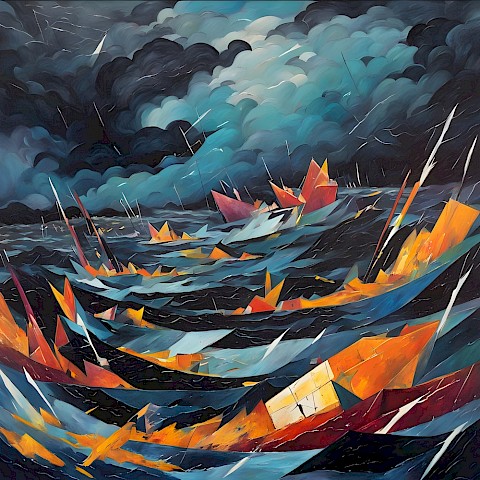|
01 IX 2025 |
14. Exhibited Oil Paintings 1830-50
518 - Slavers throwing overboard the Dead and Dying - Typhon coming on | |

| ||
|
Exhibited in 1840 with the following lines from the Fallacies of Hope: Aloft all hands, strike the top-masts and belay; Yon angry setting sun and fierce-edged clouds Declare the Typhon's coming. Before it sweep your decks, throw overboard The dead and dying - n'er heed their chains. Hope, Hope, fallacious Hope! Where is thy market now ? Several sources seem to lie behind this subject. 'Summer' in Thomson's Seasons includes an account of a typhoon. T. Clarkson's History of the Abolition of the Slave Trade, of which a second edition had just been published in 1839, gave the story of the slave-ship Zong in 1783, in which slaves dying of an epidemic were thrown overboard so that insurance, available for loss 'at sea' but not from disease, could be claimed. Topicality was also ensured by the publication in 1839 of the Life of Wilham Wilberforce (who had died in 1833) by his sons, and of his Correspondence in 1840, and by the fact that Prince Albert was the President of the AntiSlavery League. See Nos.B108-9. This picture was the most advanced of Turner's pictures to be exhibited up to this time. So full of colour in comparison to his 'grey' sea-pieces such as Nos.502 and 503, it probably stemmed from such 'unfinished' oils as the 'Stormy Sea' (No.501) though the latter is even more boldly painted. The critics were, not altogether surprisingly, overwhelmed by the picture's extravagance. The youngThackery, in ‘A Pictorial Rhapsody by Michael Angelo Titmarsh’ in Fraser’s Magazine, June 1840, wrote that it is the most tremendous piece of colour that ever was seen... Is the picture sublime or ridiculous? Indeed I don't know which. Rocks of gamboge are marked down upon the canvass; flakes of white laid on with a trowel; Bladders of vermillion madly spirited here and there... The sun glows down upon a horrible sea of emerald and purple . . . If Wilberforce's statue downstairs were to be confronted with this picture, the stony old gentleman would spring off his chair and fly away in terror!'. The Art Union for 15 May, after observing that even in his wildest caprices there is so much evidence of genius of the very highest order', exclaimed 'Who will not grieve at the talent wasted upon the gross outrage on nature' in this picture, 'the leading object in which is a long black leg, surrounded by a shoal of rainbow-hued "John Dorys", seen more clearly through the ocean surface than flies in amber'. For the Athenaeum, 16 May, it was 'a passionate extravagance of marigold sky, and pomegranate-coloured sea, and fish dressed as gay as garden flowers in pink and green, with one shapeless dusky-brown leg thrown up from this parti-coloured chaos to keep the promise of the title.' Today, on the other hand, one revels in the bravura handling and richness of colour. In 1844 the picture was given to Ruskin as a New Year's present by his father but after some years he found the subject 'too painful to live with' and sold it; bought in at Christie's in 1869 it was sold in America in 1872. Meanwhile, in the first volume of Modern Painters, 1843, Ruskin had written, 'But, beyond dispute, the noblest sea that Turner has painted, and, if so, the noblest certainly ever painted by man, is that of the Slave Ship. ... Purple and blue, the lurid shadows of the hollow breakers are cast upon the mist of night, which gathers cold and low, advancing like the shadow of death upon the guilty ship as it labours amidst the lightning of the sea, its thin masts written upon the sky in lines of blood, girded with condemnation in that fearful hue which signs the sky with horror, and mixes its flaming flood with the sunlight, and, cast far along the desolate heave of the sepulchral waves, incardines the multitudinous sea. I believe, if I were reduced to rest Turner's immortality upon any single work, I should choose this. Its daring conception, ideal in the highest sense of the word, is based on the purest truth, and wrought out with the concentrated knowledge of a life; ... and the whole picture dedicated to the most sublime of subjects and impressions (completing thus the perfect system of all truth, which we have shown to be formed by Turner's works) - the power, majesty, and deathfulness of the open, deep, illimitable sea!' An image generated by an AI Machine Learning Model Property of the artist. | ||
